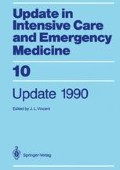Abstract
The quantification of breathing effort can be approached in three different but related ways. The first is to measure the O2 consumption difference resulting from the application or removal of a breathing stress, attributing the difference in total oxygen consumption (Δ VO2) to the activity of the respiratory pump [1]. In theory, this method has the advantage of quantifying effort at the basic level of cellular metabolism. Because the breathing effort involves muscular activity not strictly associated with useful chest movement, the A V02 technique helps account for the grossly inefficient nature of the ventilatory musculature that often characterizes critical illness. Unfortunately, it also includes a component related to the energy expended by nonrespiratory tissues as well as a component related to the expiratory work of breathing. However theoretically attractive, this methodology has several major drawbacks for clinical practice. First, the energy cost of breathing normally constitutes such a small fraction of the total body O2 requirement that precise measurement may not be easy [2]. This inherent problem of signal detection is multiplied in the clinical setting by the need to use supplemental oxygen. High inspired fractions of O2 provided at an elevated minute ventilation may be required to support the patient suffering an oxygenation crisis. As a result, large volumes of O2 are inspired and expired with every breath. By comparison, even total body O2 consumption is quite small. Therefore, the O2 sensor applied to the inspired and expired gas must be extremely accurate to prevent large percentage errors from occurring [3]. Equipment that bases the O2 consumption estimate on volumetric measurements may circumvent some of these problems, but has not yet been thoroughly evaluated.
Access this chapter
Tax calculation will be finalised at checkout
Purchases are for personal use only
Preview
Unable to display preview. Download preview PDF.
References
Cherniack RM (1959) The oxygen consumption and efficiency of the respiratory muscles in health and emphysema. J Clin Invest 38:494–499
Otis AB (1964) The work of breathing. In: Feen WO, Rahn H (eds) Handbook of physiology (Section 3, Vol 1). American Physiological Society, Washington DC, pp 463–476
Browning JA, Linberg SE, Turney SZ, Chodoff P (1982) The effects of a fluctuating FI02, on metabolic measurements in mechanically ventilated patients. Crit Care Med 10:82–85
Bigland-Ritchie B, Woods JJ (1984) Changes in muscle contractile properties and neural control during human muscular fatigue. Muscle Nerve 7:691–699
McGregor M, Becklake M (1961) The relationship of oxygen cost of breathing to respiratory mechanical work and respiratory force. J Clin Invest 40:971–980
Marini J J, Rodriguez RM, Lamb VJ (1986) Bedside estimation of the inspiratory work of breathing during mechanical ventilation. Chest 89:56–63
Marini JJ, Capps JS, Culver BH (1985) The inspiratory work of breathing during assisted mechanical ventilation. Chest 87:612–618
Marini JJ, Rodriguez RM, Lamb VJ (1986) The inspiratory workload of patient-initiated mechanical ventilation. Am Rev Respir Dis 134:902–909
Smith TC, Marini JJ (1988) Impact of PEEP on lung mechanics and work of breathing in severe airflow obstruction. J Appl Physiol 65(4): 1488–1499
Martin JG, Shore S, Engel LA (1982) Effect of continuous positive airway pressure on respiratory mechanics and pattern of breathing in induced asthma. Am Rev Respir Dis 126:812–817
Aubier M, Trippenbach T, Roussos Ch (1981) Respiratory muscle fatigue during cardiogenic shock. J Appl Physiol 51:499–508
Lemaire F, Teboul JL, Cinotti L, et al (1988) Acute left ventricular dysfunction during unsuccessful weaning from mechanical ventilation. Anesthesiology 69:171–179
Marini JJ (1986) The physiologic determinants of ventilator dependence. Respir Care 31(4): 271–282
Marini JJ, Smith TC, Lamb VJ (1988) External work output and force generating during synchronized intermittent mechanical ventilation. Am Rev Respir Dis 138:1169–1179
Marini J J (1987) The role of inspiratory circuit in the work of breathing during mechanical ventilation. Respiratory Care 32(6):419–430
Gottfried SB, Rossi A, Higgs BD, et al (1985) Noninvasive determination of respiratory system mechanics during mechanical ventilation for acute respiratory failure. Am Rev Respir Dis 131:414–420
Wright PE, Marini JJ, Bernard GR (1981) In vitro versus in vivo comparison of endotracheal tube airflow resistance. Am Rev Respir Dis 140:10–16
Marini JJ, Kirk W, Culver BH (1985) Flow resistance of the exhalation valves and PEEP devices used in mechanical ventilation. Am Rev Respir Dis 131:850–854
Marini JJ, Tyler ML, Hudson LD, Davis BS, Huseby JS (1984) Influence of head-dependent positions on lung volume and oxygen saturation in chronic airflow obstruction. Am Rev Respir Dis 129:101–105
Maclntyre NR (1986) Respiratory function during pressure support ventilation. Chest 89:677–683
Juan G, Calverley P, Talamo C, et al (1984) Effect of carbon dioxide on diaphragmatic function in human beings. N Engl J Med 310:874–879
Macklem PT (1984) Hyperinflation. Am Rev Respir Dis 131:1–2
Braun NMT, Faulkner J, Hughes RL, Roussos Ch, Sahfal V (1983) When should respiratory muscles be exercised? Chest 84:76–84
Marini JJ (1988) Monitoring during mechanical ventilation. Clin Chest Med 9:73–100
Editor information
Editors and Affiliations
Rights and permissions
Copyright information
© 1990 Springer-Verlag Berlin Heidelberg
About this paper
Cite this paper
Marini, J.J. (1990). Work of Breathing During Mechanical Ventilation. In: Vincent, J.L. (eds) Update 1990. Update in Intensive Care and Emergency Medicine, vol 10. Springer, Berlin, Heidelberg. https://doi.org/10.1007/978-3-642-84125-5_25
Download citation
DOI: https://doi.org/10.1007/978-3-642-84125-5_25
Publisher Name: Springer, Berlin, Heidelberg
Print ISBN: 978-3-540-52269-0
Online ISBN: 978-3-642-84125-5
eBook Packages: Springer Book Archive

